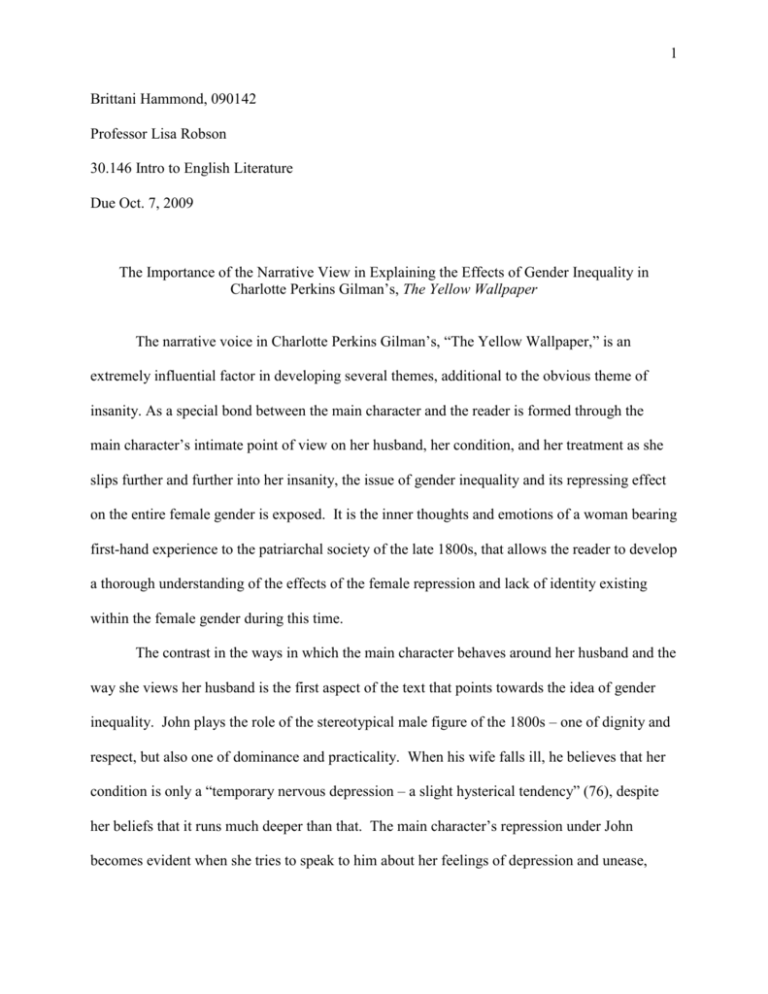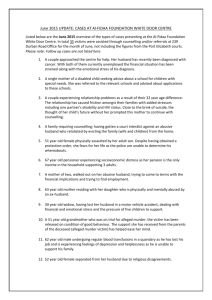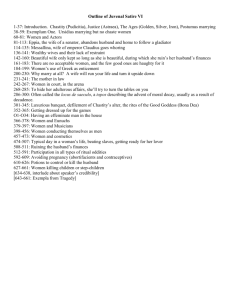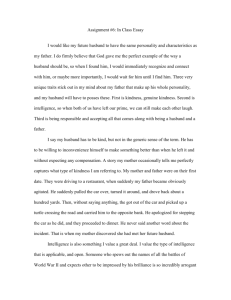Sample Essay (Format) - Ms. Hammond`s Class Website
advertisement

1 Brittani Hammond, 090142 Professor Lisa Robson 30.146 Intro to English Literature Due Oct. 7, 2009 The Importance of the Narrative View in Explaining the Effects of Gender Inequality in Charlotte Perkins Gilman’s, The Yellow Wallpaper The narrative voice in Charlotte Perkins Gilman’s, “The Yellow Wallpaper,” is an extremely influential factor in developing several themes, additional to the obvious theme of insanity. As a special bond between the main character and the reader is formed through the main character’s intimate point of view on her husband, her condition, and her treatment as she slips further and further into her insanity, the issue of gender inequality and its repressing effect on the entire female gender is exposed. It is the inner thoughts and emotions of a woman bearing first-hand experience to the patriarchal society of the late 1800s, that allows the reader to develop a thorough understanding of the effects of the female repression and lack of identity existing within the female gender during this time. The contrast in the ways in which the main character behaves around her husband and the way she views her husband is the first aspect of the text that points towards the idea of gender inequality. John plays the role of the stereotypical male figure of the 1800s – one of dignity and respect, but also one of dominance and practicality. When his wife falls ill, he believes that her condition is only a “temporary nervous depression – a slight hysterical tendency” (76), despite her beliefs that it runs much deeper than that. The main character’s repression under John becomes evident when she tries to speak to him about her feelings of depression and unease, 2 only to have him patronize and belittle her, referring to her as a “blessed little goose” (78). Instead of becoming outwardly angry with her husband, and insisting that he is incorrect, the main character simply agrees with him, evidencing the lack of opinion that she has in the relationship as opposed to the abundance of control that he possesses. Because of the main character’s subdued reactions to the denial of an opinion, one may draw the conclusion that the main character is satisfied with this life of dominance, or even miss the concept of her repression altogether - if the story had been told from any other point of view. It is the voice of the main character that informs the reader of her unhappiness and prompts him or her to identify with her situation. It is she who communicates to the reader that she truly does not agree with her husband’s ideals, but must accept them, as that is what proper women did in an era where women were held inferior to men. As the story progresses, it becomes clear that the main character’s insanity stems from the absence of a true identity. From beginning to end, a negative correlation between the character’s obedience and her insanity becomes apparent. As she becomes more and more insane from the weight of the inequality, she begins to set herself free – to release herself from repression. At the beginning, the main character obeys all of John’s commands. On her husband’s orders, she moves away from her female connections, into the unfamiliar walls of an isolated farmhouse. She resides, alone the majority of the time, in a barred up and unappealing room that she cannot stand. She accepts his diagnosis as nothing more than temporary nervousness, which can be cured by rest and nothing more, even though she knows that, “John does not know how much [she] really suffers. He knows there is no reason to suffer and that satisfies him” (77). As the story progresses, however, the main character begins to write more and more frequently, and to stay awake and study patterns in the wallpaper, forming whimsical 3 ideas that are greatly discouraged by her pragmatic husband. As the end of the story draws near, she follows these patterns beyond the line of sanity. She has reached her mental breaking point, having been separated from the small tasks that she used to either express herself (visiting with friends and relatives, writing stories) or keep her from thinking about her lack of identity (housework, entertaining). She discovers herself and the source of her instability behind the wallpaper, stating that she has “pulled off most of the paper, so that [John and Jane] can’t put me back” (87). Through her subconscious rebellion – or, insanity – towards her husband, the main character finds her identity. Through the voice of a woman going slowly insane, the reasons for her breakdown become clear to the reader. This was not a woman who could be easily dismissed by the reader as a stereotypically unstable female. This was a woman whose mental condition, combined with her desire to escape the patriarchal society in which she was raised, cracked under the pressure. The contribution of the narrative voice was that of awareness. The narrative voice highlights the issue of gender inequality in a situation, which, from the point of view of the other characters, is solely focused on insanity. The main character tied the two themes together to create an image that goes beyond husband and wife, to reflect the ideals of male superiority present within the society of the late 1800s. 4 Works Cited Lessings, Doris. “Sunrise on the Veld.” Elements of Literature Third Canadian Edition. Ed. Nancy R. Comley, Carl H. Klaus, Robert Scholes, and David Staines. Don Mills, Ontario: Oxford University Press, 2004. 223 – 229. Print.







